from: Israel Finkelstein / Neil A. Silberman:
The Bible unearthed. Archeology's New Vision of Ancient
Israel and the Origin of Its Sacred Texts; The Free
Press, a division of Simon & Schuster, Inc., 2001;
German edition has got the title "No trombones before
Jericho" (orig. German: "Keine Posaunen vor Jericho"):
edition C.H.Beck oHG, Munich 2002;
Here in this analysis is used the German version "Keine
Posaunen vor Jericho" of DTV, Munich 2004, second edition
of 2005. All page indications refer to the German version.
I hope the page numbers are not very different.
The
events in southern kingdom of Judah according to censorship
of the Old Testament and according to the documents and
findings
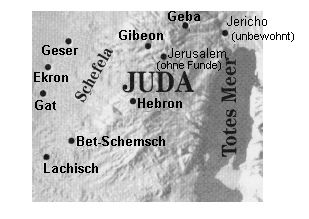 |
Map of Judah with Lachish, Shefela, Hebron, Beit
Shemsh, Ekron, Gibeon, Gat, and Geba
|
Finkelstein / Silberman give the following indications about
the OT concerning the development of the southern Reich of
Judah:
-- the data indications of the kings are right with light
corrections (p.250-251)
-- OT conceals the characters of the kings in the southern
Reich
-- "sin" in Judah is said having punished by God, and "bad"
kings are having said only for a short time (p.251).
The
documents according to the El-Amarna letters: There are
always border conflicts of Urusalim with Shechem and
the region of Shfela
In the letters found in Tell el-Amarna from Egypt the
territory of Judah is described with 6 clay tablets (p.258).
Abdi-Hepa [a king of Phoenicia] writes about Jerusalem
(named Urusalim in that time):
-- the king's citadel Urusalim (Jerusalem) is ruling
highlands with only few population
-- the territory consists of the regions of Bethel in the
North down to the region of Hebron in the South, that are
appr. 2330 km2 [for example almost
the surface of little German federal state of Saarland]
-- southern kingdom of Judah is always affected by border
clashes with the northern Reich Shechem (northern kingdom of
Israel) and with the Shfela region (p.259).
[Conclusion: Perhaps Jerusalem was in the beginning only a
tree or a stone].
Archeology about the city state
of Jerusalem (southern kingdom of Judah): there is no
statehood
OT claims that there had been a holy ideal, but all is a
fake and historically unreal. According to archeology there
exists no national religion until king Hezekiah is ruling
(p.254).
Archeology is looking for and arranging their findings for a
long time according to the biblical story and their mind is
blocked and they don't look for a new story (p.254-255).
Archeology has believed the OT for a long time, but all was
only a wishfulness (p.255).
According to Finkelstein / Silberman there has only grown
the number of the villages a little bit since the tribe
leaders David and Solomon (p.260).
Missing indications for any
statehood
-- until the late 8th century B.C. there are missing any
monumental inscriptions and seals of the kings - the
essential characteristics for a developed state (p.255)
-- ostrakas are missing (that are written clay tablets for
managing any trade)
-- and there are missing marked weight stones (p.258).
Production of potteries and the production of olive oil is
managed in local private enterprises (p.258).
|
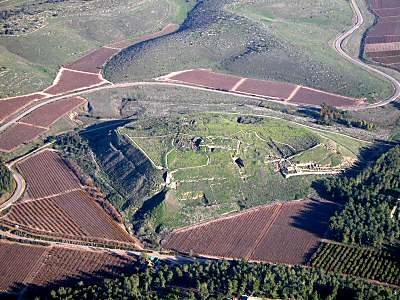
The hill of ruins
(tell) of Lachish (Lakhish), Tell
ed-Duweir
|
Regional center of Lachish
At the beginning the town of Lachish on the foothills of
the Shfela region is the only regional center in the kingdom
of Judah (p.255).
Country
style architecture
According to the archaeological research until today the
layout of town planning and architecture is generally in a
country style up to 7th century B.C. without any monumental
kind of constructive form (p.255).
The customs in the region of
Judah according to archeology - no trace of any temple
Archeology is investigating in whole Judah and can find all
possible forms of religions with figurines, altars, vessels
for libation sacrifices and altars for sacrifices. The
customs were very different and distributed in the different
centers of clans. The temple of Jerusalem - if there had
been one - was not the only center. But there is not one
single little finding of a temple in that time (p.261).
Settlement building was done with the scheme of the
"amplified family settlement" (p.261).
Religions and alleged reforms
in Judah
In the alleged first temple of Jerusalem [until today
without any findings] is said having preserved also cult
objects for Baal, Astarte, or for the heavenly hosts, and
the cult actions were performed also in the temple, also the
adoration of Mesopotamic god of Tammuz. OT qualifies all
this as "atrocities" (p.263).
The prophets of Judah are said having protested against the
"foreign gods". When we admit the description of the
conditions in Jerusalem as true, so hardly "good" and "bad"
kings can be distinguished - so Finkelstein / Silberman
(p.263).
All religious "reforms" indicated in the OT under the kings
of Judah have to be put into question - this say Finkelstein
/ Silberman, because southern Reich of Judah is rated always
as "good", and northern Reich of Israel is rated always as
"bad" (p.270).
931-914 B.C.
Southern Reich of Judah under
king Rehoboam: religious tolerance and punishment by Egypt
invasion?
OT claims:
-- king Rehoboam is says having been the alleged son of the
faked king Solomon, and it is said that under Rehoboam many
fortresses were constructed (2d book of Chronicles 11,5-12)
(p.255)
-- king Rehoboam is said having been a "sinner", and the
inhabitants are said having constructed "heights" [altars
for sacrifices on hill tops], and the inhabitants are said
having copied the atrocities of the pagans (1st book of
Kings 14,22-24) (p.251)
-- king Rehoboam is said having permitted sacrifices on all
heights, and stony monuments and pictures of Ashera on all
high hills and under all green trees (p.251)
-- king Rehoboam is said having permitted temple whore men
and all other atrocities of the pagans (1st book of Kings
14,22-24) (p.251).
Punishment is said having come in 926 B.C. by an Egypt
invasion against Jerusalem under Pharaoh Shishak, and it's
said that the temple treasuries and the palace treasuries
from the faked palace of David were taken for tribute (1st
book of Kings 14,25-26) (p.251).
Documents and archeology about
king Rehoboam
Archeology cannot find any fortress which is from the time
of Rehoboam. But there are found many monumental buildings
of the time of 200 year later (p.255).
914-911 B.C.
Southern kingdom of Judah under
king Abia
OT claims:
-- the king Abia is said having been a "sinner" as his
father, king Rehoboam (1st book of Kings 15,3) (p.251)
-- and as punishment some border clashes are said having
been with northern Reich of Israel (p.251-252).
911-870 B.C.
Southern kingdom of Judah under king Asa
OT claims:
-- king Asa is said having been a "good" king and is said
having ruled for 41 years (1st book of Kings 15,11) (p.252)
-- king Asa is said having constructed defensive works in
the biblical town of Mizpa (today in Jordan) (1st book of
Kings 15,22) (p.255)
-- under king Asa Jerusalem is said having saved by God of
the attack of the northern Reich Israel under king Baesa,
because Judah had plead for help with the king of Aram
Damascus, so Damascus had attacked Israel in the North and
Israel was forced giving up the siege of Jerusalem (p.252).
What documents and archeology
say about king Asa
Archeology is investigating the hill of ruins of Mizpa (Tell
en-Nasbe) and cannot find any fortress work which could be
allocated to king Asa, but there are many ruins that can be
allocated to a time of 200 years after (p.255).
870-846 B.C.
Southern Reich of Judah under
king Josaphat
(analyzed: Jeho-shafat, in English: God has judged)
OT claims:
-- king Josaphat is said having ruled for 25 years copying
the model of his father Asa in a loyal way to God
-- king Josaphat is said having made a peace agreement with
the northern kingdom of Israel (p.252)
-- king Josaphat is said having organized a successful
military offensive with the northern Reich of Israel against
Aram and Moab (p.252).
According to the composed OT are following "good" and "bad"
kings now, some times also both at the same time (p.252,
253).
851-843
Southern Reich of Judah under
king Jehoram
OT claims:
-- king Jehoram is said having removed the stony monument
Mazzebe of Baal and is praised for this in the OT
-- but king Jehoram is said having followed also the "sins
of Jeroboam [with golden calves] (p.243)
-- king Jehoram is said having taken a wife from a "sinful"
family of the royal family of northern Israel. He is said
having married the princess daughter of Ahab and Jezebel
Atalya
-- king Jehoram is said having introduced the cult of Baal
in Jerusalem again
-- and as punishment for his "sins" the dependent state of
Edom is said having performed a rebellion
-- and further punishment for the "sins" of Judah are said
having the loss of rich agricultural territories in the
western hilly countryside to the Philistines (p.252).
843-842 B.C.
Southern kingdom of Judah under
king Ahaziah
OT claims:
Ahaziah is said having died during the quarrels about the
succession in northern Reich of Israel during the coup of
Jehu. Then his mother Atalya is said having been got the
message of his death and is said having ordered the
liquidation of all royal descendants of the house of David
and is said having been enthroned herself (p.252).
842-836 B.C.
Southern Reich of Judah under
queen Atalya (mother of Ahaziah)
AT claims:
Temple priest Joyada is said having waited for 6 years for a
possibility for a takeover of the throne. Then he is said
having claimed that a David descendant had been safed of the
persecution of Atalya and presents Jehoash as a son of
Ahaziah with another wife. When Jehoash was anointed, Atalya
is said having been struck dead (p.252).
836-798 B.C.
Southern kingdom of Judah under
king Jehoash (alleged son of Ahaziah)
OT claims:
-- it is said that king Jehoash ruled for 40 years in
loyalty to God (2d book of Kings 12,3)
-- king Jehoash is said having renovated the temple (p.252)
[but there is missing any finding of this first temple]
-- king Jehoash is said having paid a high tribute to king
Hazael of Aram Damascus preventing an occupation of Aram
Damascus (2d book of Kings 12,18-19) (p.252-253).
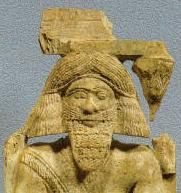
 King of
Hazael of Aram Damascus King of
Hazael of Aram Damascus
|
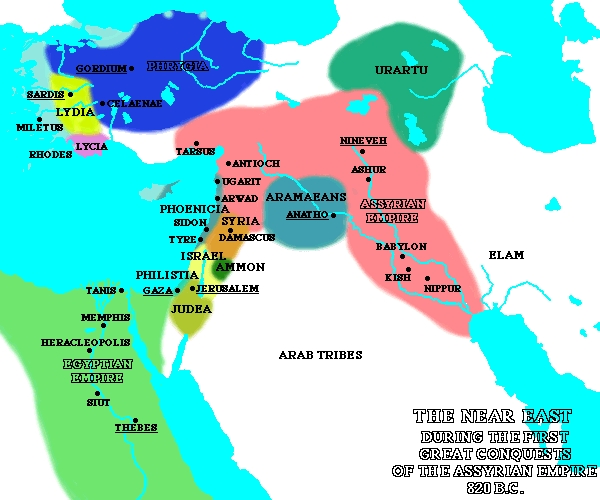
Map with Assyria and Aram Damascus in 820 B.C.
appr.
|
798-769 B.C.
Southern kingdom of Judah under
king Amaziah
OT claims:
-- king Amaziah is said having been a "good" king in loyalty
of God, but "not that good like his father David" (1st book
of Kings 14,3)
-- king Amaziah is said having organized a successful war
against Edom (p.253)
-- then is said that northern kingdom of Israel had
exploited the overspending of forces of southern Reich of
Judah and had torn down the wall of Jerusalem [but there is
no finding of the wall], and king Amaziah is said having
been defeated and seized (p.253).
According to archeology the southern Reich of Judah has
never fought any war until the northern Reich of Israel was
destroyed (p.250).
785-733 B.C.
Southern Reich of Judah under
king Uzziah
OT claims:
-- king Uzziah is said having been a "good" king
-- king Uzziah is said having "moved" the southern
borderline to Edom to the south (p.253).
|
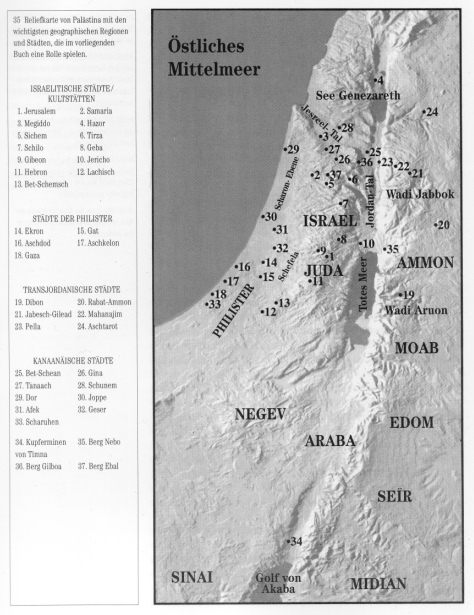
Map with Israel,
Judah, Ammon, Moab and Edom 722 appr.
|
759-743 B.C.
Southern Reich of Judah under
king Jotham (son of Uzziah)
[there is no indication].
743-727 B.C.
Southern kingdom of Judah under
king Ahaz
OT claims:
-- king Ahas is said having been a "bad" king, he is said
"having migrated on the path of the kings of Israel", he is
said having his son passed through the fire "according to
the dreadful customs of the pagans", he is said having
sacrificed sacrifices, he is said having fumigated on the
heights and on the hills under all green trees (2d book of
Kings 16,2-4)
-- as punishment for the "sins" of king Ahaz the Edomites
are said having occupied Eilat on the Red Sea and king Rezin
of Aram Damascus is said having performed a siege of
Jerusalem together with king Pekahiah from the northern
kingdom of Israel (p.253)
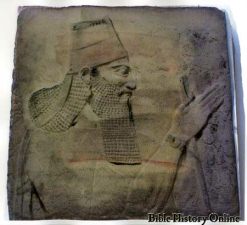
Tiglath-Pileser
III., profile, location of finding Nimrud.
|
|
-- king Ahaz is said having plead for help with
Tiglath-Pileser III (745-727 B.C.) and is said having given
him presents from the temple in advance
-- and by this Tiglath-Pileser III is said having conquered
Damascus and killed king Rezin (2d book of Kings 16,9)
(p.253).
Documents and archeology speaking about king Ahaz
As a vassal with Assyria the kingdom of Judah is not
isolated any more and begins the political game (p.263).
King Ahaz prevents the confrontation so Judah can survive.
In this way he can develop first beginnings of a public
administration (p.292).
727-698 B.C.
Southern Reich Judah under king
Hezekiah
The anointing of king
Hezekiah is said having been a great event (p.270). In the
beginning of reign of Hezekiah the southern kingdom of Judah
has about 35,000 inhabitants (p.258).
And now this king is said having been a "good" one with no
faults and only with merits (p.291).
720 B.C.
Collapse of the northern Reich of
Israel, Assyrian occupation - and the southern Reich of
Judah starts a new development





 King of
Hazael of Aram Damascus
King of
Hazael of Aram Damascus

